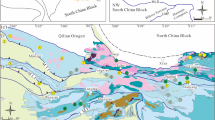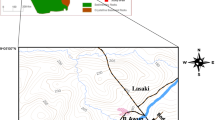Abstract
The results of the study of anomalous structures of geochemical fields (ASGF) accompanying hydrothermal gold deposits are considered. A model of the formation of such structures in the course of development of hydrothermal ore-metasomatic systems is proposed. The existing methods of detection and geometrization of ASGF are evaluated. The elaborated technique of the study of anomalous geochemical fields is based on standardized unbiased indexes assigned to detection and geometrization of anomalous structures. A classification of ASGF at hydrothermal gold deposits has been developed. General features due to the universal mechanism of functioning of hydrothermal systems and specific features related to the localization and metallogenic specialization of particular kinds of ore mineralization are identified for the studied geological and economic types of gold deposits. The elaborated technique of quantitative characterization of ASGF parameters comprises the geometrization of anomalous structures, calculation of the coefficient of ordering, and computation of the productivities of standardized indexes of zoning. The established regular variation of quantitative parameters of ASGF with depth may be applied to the estimation of the erosion level of ore-bearing structural units in ore fields and deposits.
Similar content being viewed by others
References
E. N. Baranov and A. N. Arkhangel’sky, “Scientific Principles of Geochemical Method for Forecasting of Hidden Massive Sulfide Deposits by Halos of Removal,” in Theory and Practice of Geochemical Exploration under Modern Conditions (Nauka, Moscow, 1990), pp. 108–124 [in Russian].
Vict. A. Barsukov and M. V. Borisov, “Modeling of Geochemical Implications of Automixing of Hydrothermal Solutions. III. Mass Exchange in System of Several Consecutive Rhythms,” Geokhimiya 20(11), 1562–1580 (1982).
V. I. Bazhenov, “Horizontal Zoning of Ore Mineralization in the Central Ore Field,” Izv. Tomsk. Politekhn. Inst. 177, 3–9 (1971).
A. A. Beus and S. V. Grigoryan, Geochemical Exploration of Mineral Deposits (Nedra, Moscow, 1975) [in Russian].
V. V. Bogatsky, Formation Mechanism of Structures in Ore Fields (Nedra, Moscow, 1986) [in Russian].
Directions for Geochemical Exploration of Ore Deposits, Ed. by L. N. Ovchinnikov (Nedra, Moscow, 1983) [in Russian].
N. A. Fogelman, “Main Principles of Formation Analysis of Gold-Bearing and Ores Fields for Forecast,” Otech. Geol., No. 3, 14–19 (1999).
W. S. Fyfe, N. J. Price, and A. B. Thompson, Fluids in the Earth’s Crust (Elsevier, Amsterdam, 1978; Mir, Moscow, 1981) [in Russian].
L. N. Ginzburg, V. A. Evseev, M. B. Lurie, et al., “GEOSCAN: The Software for Forecasting and Geological Exploration,” Razved. Okhr. Nedr, No. 5, 11–17 (2002).
I. S. Goldberg and D. V. Voronin, “Negative Geochemical Anomalies and Their Role in Exploration and Forecasting of Hydrothermal Ore Deposits,” in Lithochemical Exploration: Methods of Interpretation of Results (Nauka, Moscow, 1987), pp. 52–57 [in Russian].
I. S. Goldberg, G. Ya. Abramson, and V. L. Los, “Exploration of Ore Objects on Basis of Polar Zoning of Geochemical Systems,” in Applied Geochemistry (IMGRE, Moscow, 2002), No. 3, pp. 305–324 [in Russian].
A. A. Golovin, “Classification of Geochemical Zoning,” Razved. Okhr. Nedr, No. 9/10, 90–97 (2006).
V. S. Golubev and V. N. Sharapov, Dynamics of Endogenetic Ore Formation (Nedra, Moscow, 1974) [in Russian].
D. V. Grichuk and M. V. Borisov, “A Thermodynamic Model of Hydrothermal System in the Ocean Crust,” Dokl. Akad. Nauk SSSR 270(2), 424–427 (1983).
S. A. Grigorov, et al., “Structures of Geochemical Fields at Deposits of the Far East of the USSR,” Dokl. Akad. Nauk SSSR 300(1), 201–204 (1988).
S. V. Grigoryan, Primary Geochemical Halos and Their Application to Prospecting and Exploration of Ore Deposits (Nedra, Moscow, 1987) [in Russian].
C. A. Heinrich, “The Chemistry of Hydrothermal Tin-(Tungsten) Ore Deposition,” Econ. Geol. 55, 529–550 (1990).
H. C. Helgeson, “Mass Transfer among Minerals and Hydrothermal Solutions,” in Geochemistry of Hydrothermal Ore Deposits (Wiley, New York, 1976; Mir, Moscow, 1979), pp. 568–610.
I. K. Karpov, Physicochemical Numerical Modeling in Geochemistry (Nauka, Novosibirsk, 1981) [in Russian].
M. M. Konstantinov, E. M. Nekrasov, A. A. Sidorov, and S. F. Struzhkov, Gold Giants of Russia and the World (Nauchnyi Mir, Moscow, 2000) [in Russian].
I. V. Kucherenko, “Phosphorus-Magnesium-Titanium Specialization of Gold-Bearing Beresites,” Dokl. Akad. Nauk SSSR 293(2), 443–447 (1987).
N. K. Kurbanov, “Polygenetic and Multistage Gold Deposits,” in Smirnov Collection of Papers-99 (Moscow State Univ., Moscow, 1999), pp. 144–197 [in Russian].
F. A. Letnikov, Synergetics of Geological Systems (Nauka, Novosibirsk, 1992) [in Russian].
V. I. Mal’kovsky and A. A. Pek, “Effect of Focusing Properties of Highly Permeable Faults on Evolution of Ore-Forming Systems,” in Fluid Flows in the Earth’s Crust and Mantle (IGEM RAS, Moscow, 2002), pp. 104–108 [in Russian].
Methodical Recommendations on Lithochemical Exploration of Ore Deposits Using Dispersion Flows (IMGRE, Moscow, 1992) [in Russian].
Methods of Exploration of Gold Deposits (TsNIGRI, Moscow, 1991) [in Russian].
V. A. Narseev, “Theory of Endogenetic Zoning of Ore Deposits,” Otech. Geol., No. 5, 3–10 (1994).
Ore Deposits of the USSR (Nedra, Moscow, 1978), Vol. 3 [in Russian].
L. N. Ovchinnikov, Applied Geochemistry (Nedra, Moscow, 1990) [in Russian].
L. N. Ovchinnikov, V. M. Ryftin, and A. A. Golovin, Primary Geochemical Halos of Massive Sulfide Deposits and Their Implications for Geological Exploration (Nedra, Moscow, 1986) [in Russian].
V. M. Pitul’ko and I. N. Kritsuk, Principles of Interpretation of Exploration Geochemistry (Nedra, Leningrad, 1990) [in Russian].
E. V. Plyushchev and V. V. Shatov, Geochemistry and Ore Mineralization of Hydrothermal Metasomatic Rocks (Nedra, Leningrad, 1985) [in Russian].
G. L. Pospelov, Paradoxes, Geological andGeophysical Implications, and Mechanism of Metasomatism (Nauka, Novosibirsk, 1973) [in Russian].
V. Yu. Prokof’ev, Geochemistry of Ore-Forming Fluids of Hydrothermal Gold Deposits of Various Genetic Types from the Study of Fluid Inclusions (Nauka, Novosibirsk, 2000) [in Russian].
Reference Book on Mathematic Methods in Geology (Nedra, Moscow, 1987) [in Russian].
C. Y. Richardson, J. R. Cann, H. G. Richards, and J. G. Cowan, “Metal-Depleted Root Zones of the Troodos Ore-Forming Hydrothermal System, Cyprus,” Earth Planet. Sci. Lett. 846, 243–253 (1987).
L. D. M. Robertson and G. F. Taylor, “Depletion Haloes in Rocks Surrounding the Cobar Orebodies, NSW, Australia: Implication for Exploration and Ore Genesis,” J. Geochem. Explor. 27, 77–101 (1987).
N. A. Roslyakov, “Problems of Quantitative Geochemical Forecast of Ore Deposits,” in Geochemical Criteria of Forecasting of Mineralization (Nauka, Novosibirsk, 1990), pp. 193–214 [in Russian].
J. V. Rowland and R. H. Sibson, “Structural Controls on Hydrothermal Flow in a Segmented Rift System, Taupo Volcanic Zone, New Zealand,” Geofluids 4(4), 259–283 (2004).
N. I. Safronov, “On Theory of Primary Dispersed Halos,” Inf. Sb. VITR, No. 21, 106–132 (1959).
N. I. Safronov, S. S. Meshcheryakov, and N. P. Ivanov, Energy of Ore Formation and Exploration of Mineral Resources (Nedra, Leningrad, 1978) [in Russian].
Yu. G. Shcherbakov, “Geochemical Indicators of Goldfields,” Geol. Geofiz. 36(9), 42–52 (1995).
A. P. Solovov, Geochemical Exploration of Mineral Deposits (Nedra, Moscow, 1985) [in Russian].
S. V. Sokolov, Structures of Anomalous Geochemical Fields and Exploration of Mineral Resources (Nauka, St. Petersburg, 1998) [in Russian].
A. A. Tomilenko and N. A. Gibsher, “Composition of Fluids in Mineralized and Barren Zones of the Sovetskoe Quartz-Gold Deposit, Yenisei Ridge As Deduced from Fluid Inclusions Study,” Geokhimiya 39(2), 167–177 (2001) [Geochem. Int. 39 (2), 142–152 (2001)].
G. S. Vartanyan, “Fluidosphere and Endodrainage Systems of the Earth as Leading Factors of Geological Evolution,” Otech. Geol., No. 6, 14–22 (2000).
V. G. Voroshilov, “Formation Conditions of the Central Ore Field Hosted in Granitoids,” Rudy Met., No. 3, 68–80 (1995).
V. G. Voroshilov, “Complex Analysis of Structure of Anomalous Geochemical Fields, with Reference to the Rudny Altai,” in Exploration Geochemistry: Theoretical Principles, Technologies, and Results (Almaty, 2004), pp. 115–124 [in Russian].
Author information
Authors and Affiliations
Corresponding author
Additional information
Original Russian Text © V.G. Voroshilov, 2009, published in Geologiya Rudnykh Mestorozhdenii, 2009, Vol. 51, No. 1, pp. 3–19.
Rights and permissions
About this article
Cite this article
Voroshilov, V.G. Anomalous structures of geochemical fields of hydrothermal gold deposits: Formation mechanism, methods of geometrization, typical models, and forecasting of ore mineralization. Geol. Ore Deposits 51, 1–16 (2009). https://doi.org/10.1134/S1075701509010012
Received:
Published:
Issue Date:
DOI: https://doi.org/10.1134/S1075701509010012




